 |
| Nepal's people |
|
|
 |
|
 |
| Nepal's Ethnic Groups |
 |
|
|
|
|
|
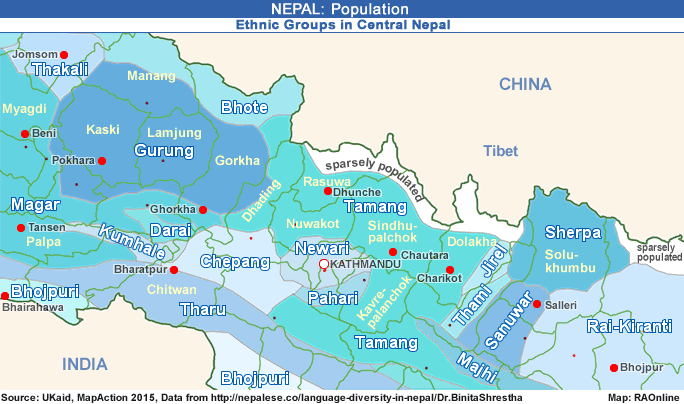 |
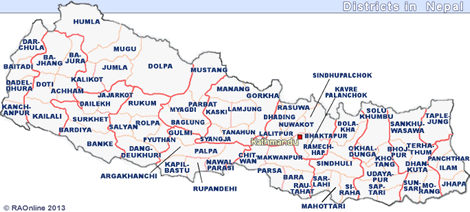
|
| The two major ethnic groups in Nepalese society are Tibeto-Burmans or Mongoloids and Indo-Aryans which came into being under the influence of China and India respectively. However, the ethnic groups of the country can be divided more or less on the basis of geographical locations. |
Sherpas
Sherpa in literal term means "people of the east" in Tibetan language. They have close affinity with Tibetan language, culture and religion. Sherpas are seen to have adopted their major occupation as agriculture, animal husbandry , trade and mountaineering. They follow Buddhism as their major religion.
Dolpo People
The settlement of these people are considered the highest settlements of the human being in the world. These people live beyond the mountain, west of Kali Gandaki river valley. These people practice Buddhist social custom.
Larke and Siar People
Larke is the northern most part of Gorkha while siar is the northern part of Dhading district. These people mainly speak Tibetan language and Gurung language and have ethnic affinity with Gurungs.
Manang Bas
The people of Manang are called Manang bas. Their major occupation include trade and business. These people have their own language and scripts. They do not care much about their religion Buddhism and hold their own local practices -Bara gaule - Baragaun in actual means 12 villages and Bara gaule stands for people of these villages. The famous pilgrim spot Muktinath lies in this area. Although Buddhism is their major religion, they also follow Bon-Po which is the religious existance of pre-Buddhist period.
Lo Pas of Mustang
The settler of Lo are called Lopas. They carry on trades with the nearest reaching points of Nepal and Tibet. Buddhism is their major religion. They have their own local language and festivities besides the religious practices.
Olangchung People
These people are the inhabitants of the trading centre Olangchung gola which is the main trading centre along the trade route in Eastern Nepal. Besides Buddhism they have their own customs and practices. Thudam, Topke Gola people and Lhomis are also other two ethnic groups of alpine region of Nepal.
| Ethnic Groups of Middle Hills and Valleys |
Brahman and Chhetris
They are quite large in number and are distributed in scattered pattern all over the country. They have sharp Indo-Aryan features and olive complexion. Brahmins are believed to have migrated from India while Chhetris are the present day Khasas from Khasi. These people follow Hinduism as their main religion and socially they have many sects. They are divided into two major streams-the Purbra and Kumain. The Kumain people are of the origin of Kumo Northern India, Uttar Pradesh.
Their social practices depend upon Hindu religious epics. They speak Nepali, the national language of Nepal and the script these people write is the devanagari script followed by sanskrit.
Kirati
Kirati mainly consists of Rai and Limbu people. Literally Rai or Limbu means 'headman'. They mainly live in far eastern part of Nepal. Kirati people are well known for their courage and bravery and are mainly observed to be recruited in armies abroad. The religious text of Limbu is "Mundhum."
Newars
Newars are mainly settled in Kathmandu valley and in major trading centres throughout the kingdom. They have Mongolian features. They have their own language (Newari) and script which is believed to have its origin in Tibeto-Burmans. Hinduism and Buddhism are their main religions. They have complex social system and practices and comprises of many castes within the group. Trade and farming are their main occupations.
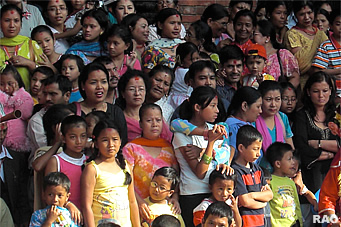 |
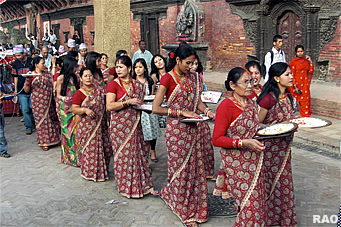 |
Tamangs
In Tibetan language 'Tamang' means horse traders. It is believed that they originally came from Tibet. Tamangs in majority live in surrounding hills of Kathmandu Valley .Their social practices and customs are based on the baseline of Buddhism.
Magars
Their origin is basically found in hill regions of westem Nepal. Their religion Buddhism and their language' Magar Kura' depicts their affinity to Tibeto -Burmese tongue and culture. Besides farming, military service, weaving, hunting and fishing are their occupations.
Gurungs
They are famous for their innocence, their simple mindedness, bravery and serving the military forces. They are mostly settled along the Annapurna areas and along the Kali Gandaki river above the Baglung district. They are ethnically related to Magars, Thakalis and even Kiratis in the eastern Nepal. Gurung love music very much and they have their own language.
Thakalis
The
origin of Thakali is Thak Khola, a high valley in central Nepal along Muktinath
region. They have Mongolian features and fair complexion but narrow eyes.
Thakalis are divided into four major groups: Gauchan, Tulachan, Sherchan
and Bhattachan. Their religion is a mixture of Buddhism, Hinduism and Jhankrism.
They are known for their hospitality, good salesmanship, and cleanliness.
 |
| Occupational Castes |
Certain
ethnic groups in Nepal are categorised according to their occupation. They
are Kamis (smiths,) Damais (tailors), Dhobis (washerman), Sarkis (cobblers),
Gaines (professional singers) and Khumbharas (porters) etc. The origin
of these castes has not been investigated yet by the anthropologists. But
Hinduism is their major religion and Nepali major language. They have their
own local festivals and practices.
Furthermore, Sunwars, Jirels, Chepangs, Kusundas and Panchgaule (five villages) are other minor ethnic groups of hill regions of Nepal.
Sunwars
and Jirels are considered to be the off- shoots of Magars. Panchgaule are
similar to Thakalis.
Kusundas still live in primitive conditions. They live in caves under trees and
in temporary huts in the forest. Only a handful of them are settled for
farming. Chepangs who themselves believe to be the off- shoots of Kirats,
are slowly coming under civilization and modernism.
| Ethnic Group of Terai Region |
Tharus
This
is the largest and oldest ethnic group of Terai belt who are found to be
living in the proximity of densely forested regions. They follow Hindu
religion and their practices are dependent on the Aryan practices. Farming
and business are their main occupations.
Danwars, Majhis and Darais are very similar to Tharus, physically and culturally. Nevertheless, they speak their own languages which are of sanskrit origin.
Rajbansis
This
is a dominant ethnic group of far eastern Terai i.e. Jhapa and Morang.
Although they follow both Hindu and Muslim religion, they have their own
local practices. Farming is their major
occupation.
Satars
They are similar to Santhals of Bihar , India. They are very much like Tharus and their social life is organised and disciplined. They believe in Hinduism. Dhimals, Bodos, Dhangars are agriculturist Hindu. Bodos are settled in Mechi Zone and are more known as Mechain- people. Dhangars who live in certain part of eastern Terai have their origin in Madhya Pradesh of India. Dhimals are Terain counterparts of the Limbus in eastern Terai, mainly in Jhapa.
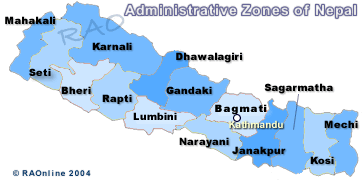
|
| more information |
|